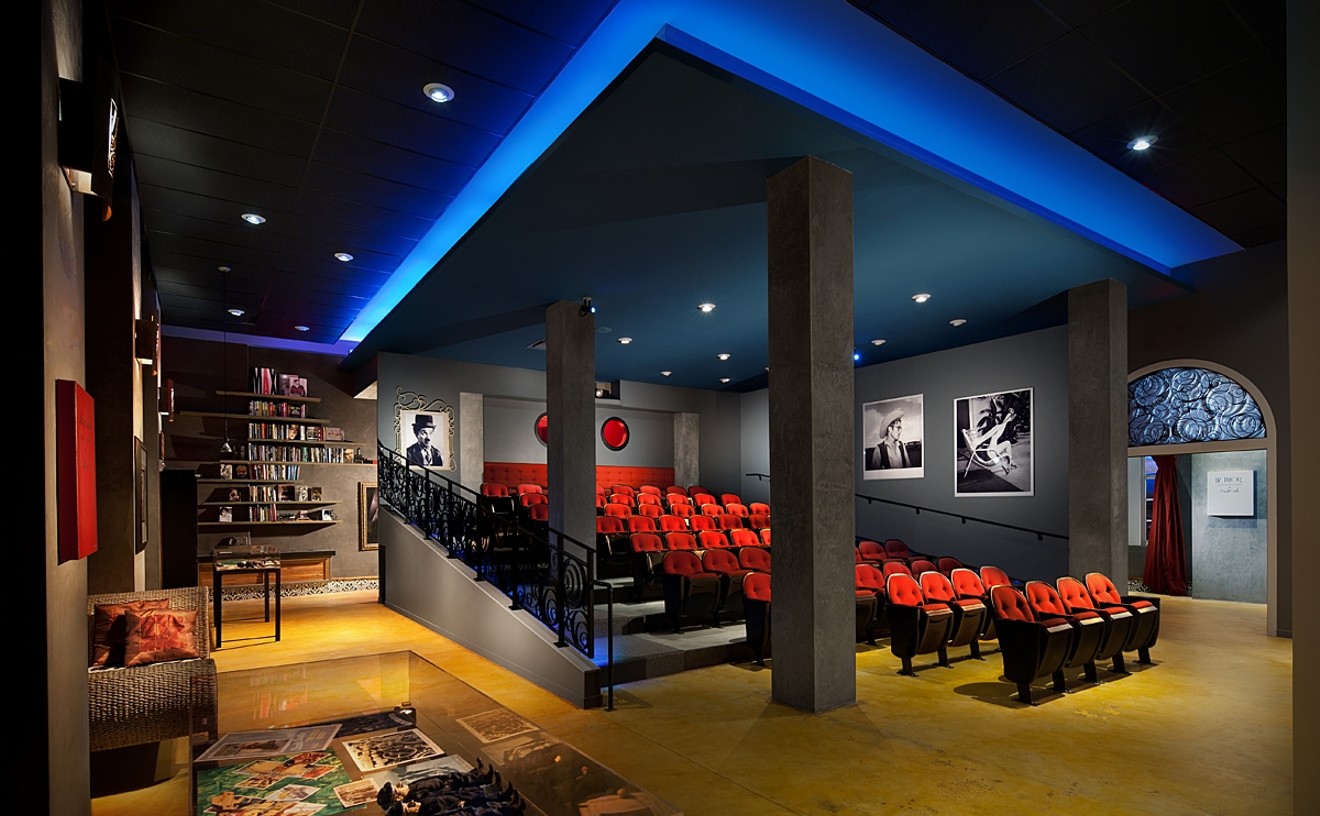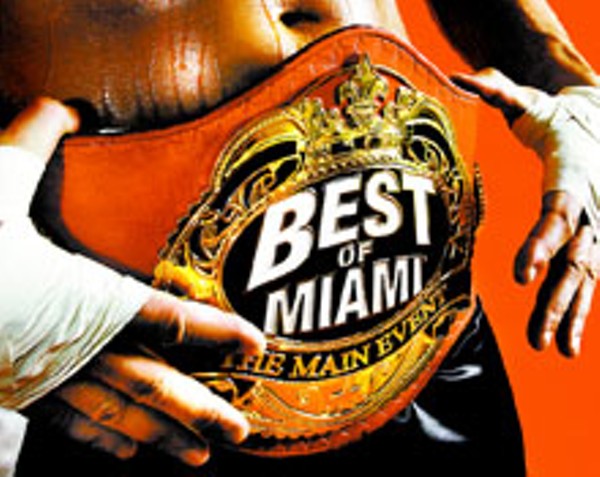Best New Law
Noise Ordinance, Miami Beach
It's not perfect, but it turns down the volume without squelching the vital tourist machine. Here's how it works: Once a code officer confirms a noise complaint, the culprit receives a written warning -- and has fifteen minutes to turn down the sound. Businesses receive three written warnings per year. (Vociferous voters got that knocked down from six at a contentious March meeting.) After that, fines ramp up. They begin paltry -- $250 for the first violation, and businesses can receive only one per day as long as they quiet down after a warning. But the new ordinance, approved March 11, takes away exceptions for special events -- like holiday weekends or Art Basel. So on the whole, the Beach should be a bit quieter for those who choose to live near the craziness.
Best Art Cinema
Miami Beach Cinematheque

Weaving a quirky collage of video, photography, installations, performance art, curated film series, and cinema-inspired live theater, this cozy film house continues drawing the culturati and curious like a magnet. Just last year, as part of its "Great Directors" series, the cinematheque delivered gems by Jean-Luc Godard, Wong Kar-Wai, Rainer Werner Fassbinder, Gus Van Sant, and David Lynch in addition to unspooling the work of local indie auteurs in the eye-opening "Featured Independent" series. Other crowd favorites included the interactive Peepshow, based on Guy Maddin's Cowards Bend the Knee, debuting during Art Basel; an exhibit of David Lynch's photography; and Rosalind Schneider's site-specific installation, WAVES, which brought the curtain down as part of the closing-night festivities for Art Miami. Other popular offerings included "Politics on Film," "Views from the uNderground," "Café con Cinema," and "Judaica on Film," plus sidebars to festivals such as the Fort Lauderdale Film Festival, Brazilian Film Festival, and Miami Gay & Lesbian Film Festival. With no signs of slowing down or resting on its laurels, the Miami Beach Cinematheque is a soothing celluloid lover's oasis in our Milk Dud-and-multiplex desert.
- 1130 Washington Ave., Miami Beach, 33139 Map
- 786-471-3269
- o-cinema.org
Best Gadfly
Steve Hagen
Steve Hagen's advocacy on behalf of an array of causes can be best summed up as an attempt to make sure Miami's development explosion benefits residents as much as developers. The 57-year-old Belle Meade resident embodies the two most important qualities of a gadfly: He is persistent, and he is annoying. Hagen, a Miamian for 22 years, attends more public meetings than most reporters, and he e-mails notes to everyone in every organization he belongs to and then some. He starts new organizations, such as Save Bicentennial Park from Massive Museums and, most recently, Citizens Against Everything Bad. He has been the most visible member of other groups (Miami Neighborhoods United, for instance). He also champions causes that range from Miami's paucity of parkland to its surplus of billboards. When City Manager Joe Arriola, a frequent Hagen target, publicly berated the activist, Hagen sent out mass e-mails detailing the experience. Not since Russ Rector's heyday of attacking the Seaquarium has this town had such a pesky advocate. "I think through sheer repetition, some of what I've been saying has gotten through," he says. "I hear people at public meetings, saying, 'Miami is at the bottom of the list for parks, and we need to do something about that.' I like to think that I helped spread that message."
Best Art Museum
Miami Art Central

Think of blockbuster exhibits. Think of provocative community-oriented programs that integrate film, literature, music, and performance with the visual arts. Think Miami Art Central. Since opening its doors in 2004, the nonprofit has blazed an impressive swath across our cultural landscape, showcasing heavyweight names and pulling in crowds with stimulating presentations of lectures, screenings, workshops, publications, and roundtable discussions. The William Kentridge exhibition -- featuring the South African artist's drawings, sculptures, and live-action films, spilling over most of the museum's 20,000-square-foot exhibition space -- was the undisputed best-of-season knockout. This bonanza's undercard weighed in with an African film festival and interesting talks about contemporary art in South Africa by curator and scholar Okwui Enwezor. Add to the mix "The Last Picture Show: Artists Using Photography (1960-1982)," one of the tightest photography surveys ever to see the daylight in these parts; the subtle "Ruth Vollmer & Gego: Thinking the Line"; and the comprehensive "Irreducible Contemporary Short Form Video," and one sees why the big-swinging institution has climbed with pizzazz to the top of the cultural ranks. Think Miami Art Central and you'll find yourself thinking of one of the most exciting cultural forums around here today. Admission is $5 for adults, $3 for seniors, free for children under twelve and students with valid ID. Free admission Sundays. Hours: Tuesday through Sunday noon to 7:00 p.m.
- 5960 SW 57th Ave., South Miami, 33143 Map
- 305-455-3333
Best Citizen
Rev. Garth Thompson, Miami Beach Community Church
Reverend Thompson has been preaching from the pulpit here since 1974, and in 32 years has put the "community" in the church's name in both word and deed. He began by encouraging blacks, Hispanics, and the homeless to join a congregation of what one current parishioner calls "a very well-gloved ladies-who-lunch crowd." Thompson threw himself, and his congregation, into community works -- hosting regular hot meals for the homeless, cleaning up Lincoln Road before it became Lincoln Road, and raising money for students who wanted to further their education but couldn't afford it. A fluent Spanish-speaker from his time preaching in Puerto Rico, he reached out to the Hispanic community during South Beach's grittier cocaine cowboy years, and he has steadfastly created public interfaith dialogues with leaders from Jewish and Muslim communities. The reverend does not adhere to any rigid doctrinaire teachings, believing "God is still speaking" and that the messages in the Bible are still evolving. To that end, he welcomes gays and lesbians to the church, and he preaches against the kind of fire-and-brimstone morality that drives so many people away from their childhood pews. The beautiful white stucco church and its visionary pastor prove, even smack-dab in the middle of South Beach, that some things -- depth, commitment, and community building -- are not only possible but also eternal.
Best Basketball Court
Overtown Youth Center

The Overtown Youth Center basketball court makes any ordinary hoopster hungry. There's something about this particular hardwood. Maybe it's the context. This freshly painted, recently polished, carefully maintained, full-size indoor gem is located in one of the slummiest, most dilapidated parts of Miami. Or maybe it's because you're not allowed to play here. The court is part of the Overtown Youth Center, an after-school program that was spurred by a multimillion-dollar donation from philanthropist Marty Margulies. It belongs to the program and is the centerpiece of a youth basketball league. Still, adults and community organizations can apply to use it. If looking at the Youth Center court gets you hot for some hoopin', simply take the short walk over to the Gibson Park courts. They aren't the field of dreams, but they'll satisfy your hoop dreams.
- 450 Northwest 14th St., Miami, FL, Miami, 33136 Map
Best Cultural Ambassador
Charlie Cinnamon
In a city where there are as many public-relations people as flashy, high-rise condos, one man stands out above the event-promoting pack. His name is Charlie Cinnamon. He's been a well-established fixture for more than 40 years. He's responsible for some of Miami's finest and longest-running cultural events. And through it all, he's remained as spicy-sweet as his name would suggest. Without Cinnamon, there would be no Coconut Grove Arts Festival. The Miami Beach Festival of the Arts probably wouldn't have become the nationally known event it is today. And local theater would be lost. Cinnamon's efforts haven't gone unnoticed. In 1983 he was honored with the Carbonell Award for Outstanding Achievement in the Arts by the South Florida Entertainment Writers Association. In 1984 the City of Miami Beach Fine Arts Board named him Man of the Year. In 1985 the PROPS Women of Show Business created the inaugural Charles Cinnamon Award, which is given out annually by the National Foundation for Advancement in the Arts. This past March 25, 2006, Cinnamon was awarded the Playhouse Lifetime Community Achievement Award for his decades-long work in promoting the Magic City and its various cultural institutions. The award was presented by none other than suspenders-sporting CNN talk show host Larry King. Although he regularly deals with high-power celebrities, including Liza Minnelli, Mikhail Baryshnikov, Gloria Estefan, and Princess Caroline of Monaco, Cinnamon remains a man of the people who would rather enjoy lunch alfresco on Lincoln Road than spend time sucking up to name-dropping wannabes. Other self-described PR superstars and celebrity sycophants should learn from Charlie. He's lasted this long for a reason. Quite simply, he's tops.
Best Beach
Crandon Beach
Visit Crandon Beach on a gusty day and, for a $5 parking fee, here's what you'll find: kite surfers swooping and twirling in the distance and sandpipers dozing on one leg just offshore. The placid, lagoonlike waters make Crandon a perfect spot for swimming or wading. And its near-empty beaches are a welcome retreat from Miami Beach favorites. Besides, no other local waterfront spot can rival Crandon's velvety white sand and plentiful amenities -- among them meandering promenades, ample picnic areas, shaded pavilions, outdoor showers, and concession stands. For those with children, there's the Family Amusement Center with its antique carousel, roller rink, and sandy playground. You can also rent cabanas, complete with private restrooms and showers, for $20 per day or $200 per month. These small, mostly concrete spaces are better suited to storing lounge chairs and surfboards than lingering over mojitos. But who really needs a roof when there's so much sand to ply? And once you've had your fill of beach, you can sample some of Crandon Park's other offerings, such as fine restaurants, tennis courts, and a championship eighteen-hole golf course.
Best Local Boy Made Good
Sidney Poitier
Born in Miami during a mainland visit by his Bahamian parents, this great American actor came to the Magic City as a fifteen-year-old in 1942 and remained in the United States after that. At first he had a really rough time, experiencing racism and difficulty in getting a job, which inspired his civil rights activism as an adult. Poitier joined the U.S. Army at age eighteen and while on leave auditioned impulsively for a Broadway production of Lysistrata. He got the part, and within a decade had copped the Oscar for his performance in 1963's Lilies of the Field, the first black to win in a leading role. Poitier maintained activity onstage, onscreen, and in the burgeoning civil rights movement. Roles in Guess Who's Coming to Dinner (1967), as the suitor of a white woman (and by extension her uptight family), and To Sir, with Love (1967), as a teacher and inspiration to a bunch of teen hoodlums, were landmarks of their time. Today those films are still eminently watchable, in large part owing to Poitier's elegant elocution and reserved manner. And don't even get us started on They Call Me Mr. Tibbs.
Best Book by a Local Author
Finding Mañana: A Memoir of a Cuban Exodus by Mirta Ojito
In 1980 more than 125,000 Cubans fled the iron fist of Fidel Castro in what would become known as the Mariel Boatlift. Mirta Ojito was born in Cuba and lived in a one-bedroom apartment in Havana for sixteen years until her family joined the exodus to the United States. Ojito's family made it to Florida together, but many others were not as fortunate. Finding Mañana paints a bleak picture of the postmodern Cuba where self-expression was a crime and religion was rejected. But not all is despair and tribulation. As Ojito puts it: "We left the way one leaves a cherished but impossible love: our hearts heavy with regret but beating with great hope.''





